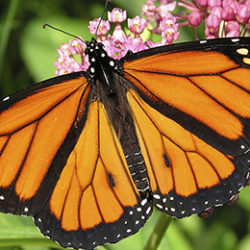What do you think of when you hear the term “circadian rhythm”? For most of us, it’s “jet lag”, because that’s the way we’ve likely encountered it. But “circadian”, which refers to anything biological that goes through a cycle in about 24 hours, applies to many aspects of the lives of plants, animals, and even bacteria.
A flower led the way
Daily variations in the behaviors of plants and animals have been known about since antiquity. But the first scientist to put some experimental muscle into the idea of circadian rhythm was an astronomer with the flowery name of Jean Jacques d’Ortous de Mairan (yes, he was French). In 1729, he did an experiment that gave a first inkling of what circadian rhythm is really about. He made his observations on a little flowering plant called mimosa pudica.

de Mairan may have been attracted to mimosa pudica because it exhibits an unusual and spirited kind of motion; when touched, the leaves fold inward and down (one of its colloquial names is “the shy plant”). Its leaves also fold inward at night, and re-open at dawn. For reasons unknown, de Mairan placed the plants in a room that was in constant dim light. He noticed that the leaves still continued to close and open each day. In other words, the cyclic, daily behavior wasn’t driven by the rising and setting of the sun, in contrast to what most people believed. (Most people today still think that, unless they’ve seen a good science fair project about the subject.)
Although reluctant to publish (maybe astronomers shouldn’t be working on little flowers?) de Mairan folded in response to prodding by his friends, and published a one-page description of his results in the Annals of the Royal Society of France. Based on his cautious report it would have been reasonable to conclude that, if it wasn’t the rising and setting of the sun that caused leaf movement, some other aspect of the earth’s rotation might be responsible. Maybe it was driven by the subtle temperature changes over 24 hours, or the nearly-daily lunar tug that causes tides to rise and ebb.
De Mairan’s conclusion was disputed, but it was also repeated and verified. The next big step forward occurred almost 100 years later. The Swiss botanist Augustin Pyramus de Candolle (another lovely name) noticed something that de Mairan hadn’t: the cycle of leaf opening and closing in constant light in the plants he was studying had a period of 22 hours, not 24. That meant it couldn’t be driven by any daily cycle related to the earth’s rotation, or the lunar day. Circadian rhythm (the term wasn’t coined for another 100 years) was an innate property of the plant, not a response to any external cyclic process. And it had a period of about a day – “circa diem”.
Circadian rhythm is in the bean’s genes
When I was a graduate student in biochemistry back in the 1960s, I stumbled on a metabolic reaction sequence that oscillated; it went up and down with a period of about a minute. I was monitoring that reaction by shining light of a specific wavelength through it, and its transparency to that light was registering continuously. So the reactions could be followed by the second, and it was fascinating. The reaction moved back and forth on its own, the trace on the graph a graceful sinewave. But it was a complex system, and although it could be understood in a general way, I never did find out exactly what was going on.
The intrigue of oscillating biological systems never went away, although I had to put it on hold for about 40 years, until I was almost retired. Then, what goes around came around. I became fascinated by circadian rhythm, another biological system that oscillates, and I got together with a colleague who was studying the growth of beans. I wanted to look at a system that showed circadian rhythm, and plants were the easiest choice. Beans, like de Mairan’s little flowers, raise and lower their leaves during the day. It’s a mechanism to conserve water — there is less transpiration when the leaves are hanging down and flaccid during the night. But one day I noticed something surprising. Circadian rhythms are not usually exactly 24 hours long, and like a poor clock, they are re-set by the 24 hour period of the day when growing out of doors. The implication is that this re-setting mechanism is what starts off the circadian cycling in the first place. But when I planted and grew beans in constant light, the leaves began to cycle on their own. They folded down, and “awoke”, with a period of just under 27 hours. The time lapse movie below shows a common bean plant being born into the light, and staying there as it grows.

The plant takes a little while to get going (I’ve included the time course from the beginning to show that it was never subjected to light-dark cycles). It pokes its head out and starts growing in constant light, and suddenly, still in constant light, it begins to wave to the audience. Analysis of the cycles of leaf lowering and raising shows a period of close to 27 hours, so it couldn’t be due to a cyclic temperature change during the day. Not only is the ability to undergo circadian rhythm intrinsic to the plant, so is the ability to start the cycles. It’s all built in, genetically speaking.
My elation at this surprising result was tempered when I found the same result, published forty years earlier, at about the same time I had my first encounter with biological oscillators as a graduate student (1). In a clear and unequivocal series of experiment, scientist at UCLA had shown that beans grown in continuous light would start raising and lowering their leaves with a 26 hour period (they used different beans), automatically, without ever having experienced sunrise and sunset. They further showed that the intensity of the artificial light they were grown in had an effect on whether the two leaves of the early bean plant moved synchronously or not. I don’t think anyone has an explanation for that.
The historical genetics of plant movement
In 1880 Charles Darwin, together with his son Francis, published a book called “The Power of Movement in Plants”, in which they concluded that movement in plants “has been acquired at least in most cases, for some special purpose.” In the language of genetics, which hadn’t been invented yet, we would say that plant movement is due to genetic selection. That book was one of Darwin’s worst sellers — the first edition sold only 1,500 copies. Nobody was much interested in the arcane behavior of plants.
Today, we ascribe almost every aspect of life to genetics (as modified by experience and environment, of course), and it’s not surprising that circadian rhythm would also have a genetic base. Plants also provided the first clear evidence of this. In 1932, the German botanist Erwin Bünning showed that the period of the circadian rhythm of the common bean, the time cycle over which it raised and lowered its leaves, was controlled by its genes. He isolated cultivars with different circadian periods, and showed that they bred true. Then he hybridized them genetically, and found that the behavior of the hybrids had various circadian periodicities. He concluded that several genes were involved in circadian behavior. History tells us he was right.
In the molecular era in biology, we seek explanations in genetic and chemical terms. Circadian rhythm is a difficult phenomenon to describe in this way, partly because it isn’t the same wherever it occurs. It’s clear that it was “invented” during the evolution of different living things in different ways. Plants, animals and bacteria have found different ways to create their circadian rhythms. The different circadian systems in biology have interesting things to tell us about how fruit flies attract the opposite sex, why some of us are morning people and some prefer late evenings, and why medicines may affect us differently depending on when they are administered. These subjects will be explored in future posts.
Go to Latest Posts
- Hoshizaki, T., and K. C. Hamner. 1964. Circadian leaf movements: Persistence in bean plants grown in continuous high-intensity light. Science 144:1240-1241.




